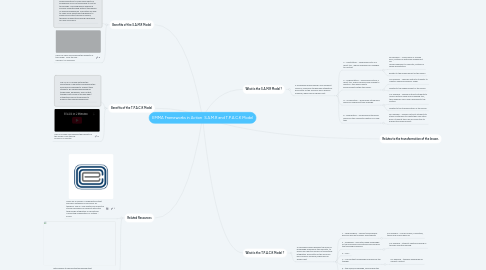
1. Benefits of the S.A.M.R Model
1.1. The S.A.M.R model is a great tool for educators beginning to merge technology into their teaching practice. The model allows educators to make small shifts of progression from no technology to alot of technology. This progressive approach ensures understanding without the feeling of being overwhelmed. Educators are able to make small adjustments gradually to enhance and later transform lessons, therefore making the learning experience fun and successful.
1.2. Here is a video summarizing the benefits of this model. Click the link - SAMR in 120 Seconds
2. Benefits of the T.P.A.C.K Model
2.1. The T.P.A.C.K model outlines the importance of educators possessing the necessary knowledge to support their students. By merging knowledge of technology, pedagogy, and content, teachers will be well informed when integrating various technology to enhance the learning experience.
2.2. Here is a video summarizing the benefits of this model. Click the link TPACK in 2 Minutes
3. Related Resources
3.1. There are a number of organizations that provide a database of resources for teachers. The on I feel relates and reflects a strong framework for support with intial technology integration is Educational Computing Organization of Ontario - ECOO
3.2. With regards to gaining that knowledge that empompasses the parts of the T.P.A.C.K model, the EduGains database would be best. This site provides knowledge surrounding technology, pegagogy and educational content - EduGAINs Home
4. Relates to the transformation of the lesson.
5. What is the S.A.M.R Model ?
5.1. A framework which displays four different levels of classroom technology integration. Each letter of the acronym has a specific meaning, which will be shown next.
5.1.1. S - Substitution - Technology acts as a direct tool , which undergoes no changes to function.
5.1.1.1. For example - Using Word or Google Docs, instead of writing an assignment. OR Using Powerpoint or Keynote, instead of verbal presentation.
5.1.1.2. Relates to the enhancement of the lesson.
5.1.2. A - Augmentation - Technology acts as a direct tool, which causes some change to function. This would lead to improvements within the lesson.
5.1.2.1. For example - Teacher instructs students to create a shared DROPBOX folder.
5.1.2.2. Relates to the enhancement of the lesson.
5.1.3. M - Modification - Technology introduced allows for significant task redesign.
5.1.3.1. For example - Teacher instructs students to draw a picture using online drawing tool, then adding a voice over recording to the picture.
5.1.3.2. Relates to the transformation of the lesson.
5.1.4. R - Redefinition - Technology introduced allows for the complete creation of a new task.
5.1.4.1. For example - Teacher instructs students to utilize multimedia to create their own story book. Students then use an online tool to publish the finish product.
6. What is the T.P.A.C.K Model ?
6.1. A framework which displays the kinds of knowledge required by the educator, to ensure an effective means of technology integration. Each letter of the acronym has a specific meaning, which will be shown next.
6.1.1. T - Technological - various technological devices used by teachers and students
6.1.1.1. For example - SMART boards, computers, tables and mobile devices.
6.1.2. P - Pedagogy - educators deep knowledge of the processes and methods surrounding the teaching profession.
6.1.2.1. For example - students centred learning or teacher directed learning.
6.1.3. A - and ...
6.1.4. C - The content knowledge posessed by the teacher.
6.1.4.1. For example - teachers knowledge of subject content.
6.1.5. K - the overall knowledge, surrounding the three parts: technology, pedagogy and content.

